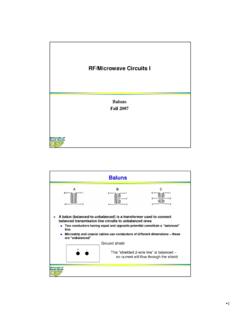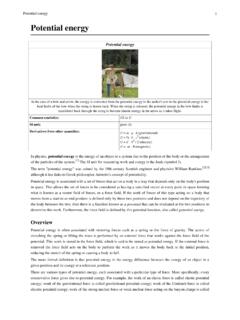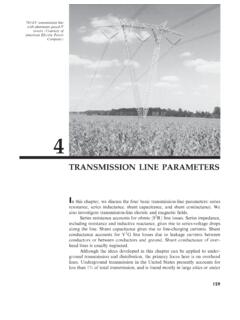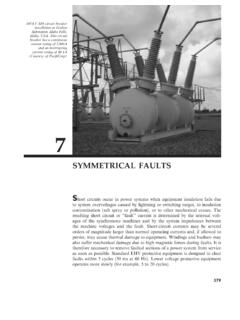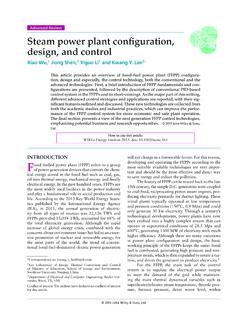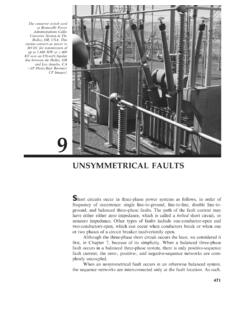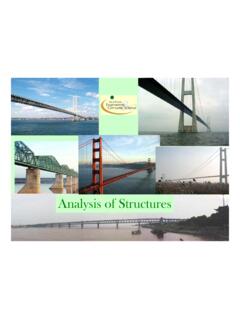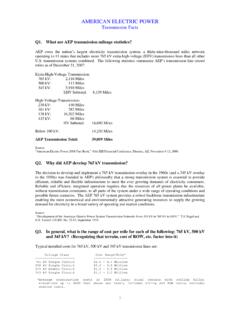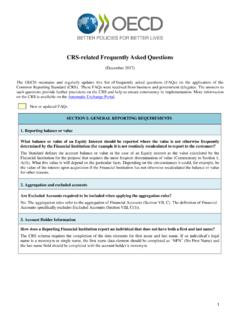Transcription of Understanding Power System Harmonics - Baylor University
1 Harmonics Chapter 1, Introduction April 2012 Mack Grady, Page 1-1 Table of Contents Chapter 1. Introduction Chapter 2. Fourier Series Chapter 3. Definitions Chapter 4. Sources Chapter 5. Effects and Symptoms Chapter 6. Conducting an Investigation Chapter 7. Standards and Solutions Chapter 8. System Matrices and Simulation Procedures Chapter 9. Case Studies Chapter 10. Homework Problems Chapter 11. Acknowledgements Appendix A1. Fourier Spectra Data Appendix A2. PCFLO User Manual Appendix A3. Harmonics Analysis for Industrial Power Systems (HAPS) User Manual and Files 1. Introduction Power systems are designed to operate at frequencies of 50 or 60Hz. However, certain types of loads produce currents and voltages with frequencies that are integer multiples of the 50 or 60 Hz fundamental frequency.
2 These higher frequencies are a form of electrical pollution known as Power System Harmonics . Power System Harmonics are not a new phenomenon. In fact, a text published by Steinmetz in 1916 devotes considerable attention to the study of Harmonics in three-phase Power systems. In Steinmetz s day, the main concern was third harmonic currents caused by saturated iron in transformers and machines. He was the first to propose delta connections for blocking third harmonic currents. After Steinmetz s important discovery, and as improvements were made in transformer and machine design, the Harmonics problem was largely solved until the 1930s and 40s. Then, with the advent of rural electrification and telephones, Power and telephone circuits were placed on common rights-of-way. Transformers and rectifiers in Power systems produced harmonic currents that inductively coupled into adjacent open-wire telephone circuits and produced audible telephone interference. These problems were gradually alleviated by filtering and by Understanding Power System Harmonics Prof.
3 Mack Grady Dept. of Electrical & Computer Engineering University of Texas at Austin ~grady Harmonics Chapter 1, Introduction April 2012 Mack Grady, Page 1-2 minimizing transformer core magnetizing currents. Isolated telephone interference problems still occur, but these problems are infrequent because open-wire telephone circuits have been replaced with twisted pair, buried cables, and fiber optics. Today, the most common sources of Harmonics are Power electronic loads such as adjustable-speed drives (ASDs) and switching Power supplies. Electronic loads use diodes, silicon-controlled rectifiers (SCRs), Power transistors, and other electronic switches to either chop waveforms to control Power , or to convert 50/60Hz AC to DC. In the case of ASDs, DC is then converted to variable-frequency AC to control motor speed.
4 Example uses of ASDs include chillers and pumps. A single-phase Power electronic load that you are familiar with is the single-phase light dimmer shown in Figure By adjusting the potentiometer, the current and Power to the light bulb are controlled, as shown in Figures and Figure Triac light dimmer circuit Triac (front view) MT1 MT2 G + 120 Vrms AC Light bulb G MT2 MT1 F 250k linear pot TriacBilateral trigger diode (diac) a c n b Light bulb a n b Before firing, the triac is an open switch, so that practically no voltage is applied across the light bulb. The small current through the resistor is ignored in this diagram. + 0V + Van + Van After firing, the triac is a closed switch, so that practically all of Van is applied across the light bulb. Light bulb a n b + Van + Van + 0V Harmonics Chapter 1, Introduction April 2012 Mack Grady, Page 1-3 Figure Light dimmer current waveforms for firing angles = 30 , 90 , and 150 Figure Normalized Power delivered to light bulb versus 030 60 90 120 150 180 210 240 270 300 330 360 AngleCurrent030 60 90 120 150 180 210 240 270 300 330 360 AngleCurrent0306090120150180210240270300 330360 AngleCurrent = 30 = 90 = 150 Harmonics Chapter 1, Introduction April 2012 Mack Grady.
5 Page 1-4 The light dimmer is a simple example, but it represents two major benefits of Power electronic loads controllability and efficiency. The tradeoff is that Power electronic loads draw nonsinusoidal currents from AC Power systems, and these currents react with System impedances to create voltage Harmonics and, in some cases, resonance. Studies show that harmonic distortion levels in distribution feeders are rising as Power electronic loads continue to proliferate and as shunt capacitors are employed in greater numbers to improve Power factor closer to unity. Unlike transient events such as lightning that last for a few microseconds, or voltage sags that last from a few milliseconds to several cycles, Harmonics are steady-state, periodic phenomena that produce continuous distortion of voltage and current waveforms. These periodic nonsinusoidal waveforms are described in terms of their Harmonics , whose magnitudes and phase angles are computed using Fourier analysis.
6 Fourier analysis permits a periodic distorted waveform to be decomposed into a series containing dc, fundamental frequency ( 60Hz), second harmonic ( 120Hz), third harmonic ( 180Hz), and so on. The individual Harmonics add to reproduce the original waveform. The highest harmonic of interest in Power systems is usually the 25th (1500Hz), which is in the low audible range. Because of their relatively low frequencies, Harmonics should not be confused with radio-frequency interference (RFI) or electromagnetic interference (EMI). Ordinarily, the DC term is not present in Power systems because most loads do not produce DC and because transformers block the flow of DC. Even-ordered Harmonics are generally much smaller than odd-ordered Harmonics because most electronic loads have the property of half-wave symmetry, and half-wave symmetric waveforms have no even-ordered Harmonics . The current drawn by electronic loads can be made distortion-free ( , perfectly sinusoidal), but the cost of doing this is significant and is the subject of ongoing debate between equipment manufacturers and electric utility companies in standard-making activities.
7 Two main concerns are 1. What are the acceptable levels of current distortion? 2. Should Harmonics be controlled at the source, or within the Power System ? Harmonics Chapter 2, Fourier Series April 2012 Mack Grady, Page 2-1 2. Fourier Series General Discussion Any physically realizable periodic waveform can be decomposed into a Fourier series of DC, fundamental frequency, and harmonic terms. In sine form, the Fourier series is 11)sin()(kkkavgtkIIti , ( ) and if converted to cosine form, becomes 11)90cos()(kokkavgtkIIti . avgI is the average (often referred to as the DC value dcI). kI are peak magnitudes of the individual Harmonics , o is the fundamental frequency (in radians per second), and k are the harmonic phase angles. The time period of the waveform is 1111222ffT.
8 The formulas for computing dcI, kI, k are well known and can be found in any undergraduate electrical engineering textbook on circuit analysis. These are described in Section Figure shows a desktop computer ( , PC) current waveform. The corresponding spectrum is given in the Appendix. The figure illustrates how the actual waveform can be approximated by summing only the fundamental, 3rd, and 5th harmonic components. If higher-order terms are included ( , 7th, 9th, 11th, and so on), then the PC current waveform will be perfectly reconstructed. A truncated Fourier series is actually a least-squared error curve fit. As higher frequency terms are added, the error is reduced. Fortunately, a special property known as half-wave symmetry exists for most Power electronic loads. Have-wave symmetry exists when the positive and negative halves of a waveform are identical but opposite, , )2()(Ttiti , where Tis the period. Waveforms with half-wave symmetry have no even-ordered Harmonics .
9 It is obvious that the television current waveform is half-wave symmetric. Harmonics Chapter 2, Fourier Series April 2012 Mack Grady, Page 2-2 Figure PC Current Waveform, and its 1st, 3rd, and 5th Harmonic Components (Note in this waveform, the Harmonics are peaking at the same time as the fundamental. Most waveforms do not have this property. In fact, in many cases ( a square wave), the peak of the fundamental component is actually greater than the peak of the composite wave.) -505 Amperes1 Sum of 1st, 3rd, 5th 35-505 Amperes Harmonics Chapter 2, Fourier Series April 2012 Mack Grady, Page 2-3 Fourier Coefficients If function )(ti is periodic with an identifiable period T ( , )()(NTtiti ), then )(ti can be written in rectangular form as 111)sin()cos()(kkkavgtkbtkaIti , T 21 , ( ) where TototavgdttiTI)(1, TototkdttktiTa1cos)(2 , TototkdttktiTb1sin)(2.
10 The sine and cosine terms in ( ) can be converted to the convenient polar form of ( ) by using trigonometry as follows: )sin()cos(11tkbtkakk 221122)sin()cos(kkkkkkbatkbtkaba )sin()cos(12212222tkbabtkbaabakkkkkkkk )sin()cos()cos()sin(1122tktkbakkkk , ( ) where 22)sin(kkkkbaa , 22)cos(kkkkbab . Applying trigonometric identity )sin()cos()cos()sin()sin(BABABA ak bk k Harmonics Chapter 2, Fourier Series April 2012 Mack Grady, Page 2-4 yields polar form )sin(122kkktkba , ( ) where kkkkkba )cos()sin()tan( . ( ) Phase Shift There are two types of phase shifts pertinent to Harmonics .
